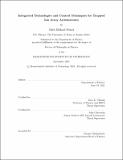Integrated Technologies and Control Techniques for Trapped Ion Array Architectures
Author(s)
Stuart, Jules Michael
DownloadThesis PDF (29.99Mb)
Advisor
Chuang, Isaac L.
Chiaverini, John
Terms of use
Metadata
Show full item recordAbstract
Over the past few decades, trapped ions have emerged as one of the top contenders for realizing large scale quantum information processing. To date, experiments with ions have reached the level of tens of ion qubits, but the current model of adding ions to long chains may not extend to the number required for some computations. An alternative architecture, which has been recently explored, is to arrange ions in a large array, such that they can be shuffled around to transmit quantum information around a chip. This approach promises greatly increased numbers of qubits, while maintaining speed, fidelity and connectivity, but as the scale of these arrays increases, the required density of control systems may become intractable with current methods. In this thesis, we explore the integration of classical control technologies into ion traps and investigate whether this can provide the level of control needed to establish the array architecture as a more viable path toward more complex trapped-ion quantum computers. We focus first on the integration of classical, cryogenic electronics into an ion trap, which are used to control an ion’s trap frequency and demonstrate rudimentary motion. An integrated switch allows the ions to be isolated from the effects of voltage noise. Next, we demonstrate the operation of a stimulated Brillouin scattering (SBS) laser for addressing an ion in an atomic clock protocol. In our experiment, the SBS laser is shown to have a linewidth commensurate with a bulk-cavity-stabilized laser and may offer a path towards generating highly-coherent light within an ion trap package. Subsequently, we explore the integration of photonic waveguides and grating couplers which can route laser light around on-chip and focus light onto ions trapped above the chip. The effects of stray electric field are considered, and the benefits of integrated light sources are characterized. In an array architecture, it will be important to be able to transport ions around between zones without introducing excessive motional decoherence. We present a technique using circuit simulation to pre-distort voltage waveforms for fast transport and demonstrate the basic operation of a trap designed to rapidly split and join ion chains. The studies covered here help inform future ion-trap architecture decisions and set the stage for further analysis of tradeoffs between these different technologies.
Date issued
2021-09Department
Massachusetts Institute of Technology. Department of PhysicsPublisher
Massachusetts Institute of Technology